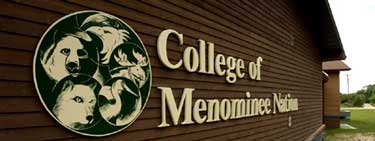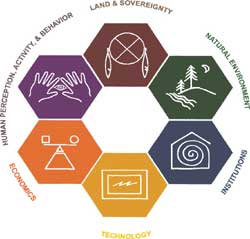Tiempo Climate Cyberlibrary
Indigenous Dialogue on Sustainable Development
 |
Bill Van Lopik outlines the results of a recent
international dialogue that focused on the models of
sustainable development and positive practices of
indigenous peoples.
The author is Academic Program Director for the
Sustainable Development Institute at the College of
Menominee Nation in Keshena, Wisconsin, in the United
States.
|
An opportunity to give voice to realities and studies of
sustainability practices and concepts within indigenous
communities was realized in June 2004 with the conference,
"Sharing Indigenous Wisdom: An International Dialogue
On Sustainable Development".
The conference was hosted by the College of Menominee
Nation's Sustainable Development Institute. The
College of Menominee
Nation is a tribally controlled community college
located in northeast Wisconsin in the United States. The
college and institute were organized in 1993 by Menominee
community leaders representing a broad spectrum of
institutional interests including governance, commerce,
education and natural resource management.
|

|
© Lisa Marchel
|
The mission of the Sustainable
Development Institute is two-fold: to reflect upon and
disseminate the expertise of the
Menominee people in sustainable development, and to
advance the tenets of sustainability to other economic and
social sectors.
Menominee expertise in forest management has gained
wide-spread attention, receiving commendation by the United
Nations in 1995, and designation as the first recipient of
the United States Presidential Award
for Sustainable Development in 1996. The conference was
the fulfilment of a long-time dream of the Institute staff
of hosting an international conference with a focus on the
foundational elements of the Menominee model of sustainable
development.
The Menominee model of sustainable development is a
theoretical model that conceptualizes sustainable
development as the process of maintaining the balance and
reconciling the inherent tensions between the various
dimensions of sustainability.
|

|
The six dimensions are:
- land and sovereignty;
- natural environment;
- institutions;
- technology;
- economics; and,
- human perception, activity and behaviour.
|
Each dimension is understood to be dynamic, both in
respect to its internal organization, and in relationship
to each of the other five dimensions of the sustainable
development process.
The model takes as its point of departure that change
within one dimension will impact other dimensions in an
ever-unfolding diffusion of responses to change, whether
externally driven or inherent to the dynamism of a specific
dimension. Topics which reflect the interface of any two or
more dimensions of sustainability are central to the
Institute's interests, and are engaged through
independent, collaborative and sponsored research and
dissemination of information.
The Sharing Indigenous
Wisdom conference brought representatives across
political, social, economic, institutional and cultural
boundaries from around the globe to Green Bay, Wisconsin.
The ideals, values, customs and traditions of diverse
indigenous cultures focused upon developing sustainable
models of technology, economics, land and sovereignty,
natural environment, institutions and human perception and
behaviours in contemporary societies.
Twenty three practitioners and scholars delivered papers
and made presentations outlining sustainable practices and
models. These presentations were grouped into four topical
areas at the conference. They included: Sustaining the
Wisdom, Sustaining the Nation, Sustaining the Spirit and
Sustaining the Earth.
Seventy registered participants participated in a salon
discussion model following each of the four topical
sessions. The salon model facilitated dialogue among
participants allowing conference attendees the opportunity
to discuss areas of interest and concern derived from the
information presented in the sessions.
The context of the conference was framed by Verna
Fowler, President and Founder of the College of Menominee
Nation. She opened the conference by recognizing that the
Menominee Nation has been internationally acknowledged for
its leadership in sustainable development and takes pride
in its legacy of stewardship of its forested ancestral
lands, and honours those similar efforts of other
indigenous communities globally.
She clearly framed the goal of the conference by saying
that "collectively those efforts will not only assure
a high quality of life for the future generations of our
communities, but also make a positive contribution to the
global body of knowledge on how best to achieve sustainable
development among the community of nations".
The first theme centred upon "Sustaining the
Wisdom". Papers were presented within this theme on
how indigenous knowledge and philosophy is embraced in a
variety of ways. For example, Ojibwa philosophy has been
instrumental in the planning of the academic and building
facilities at the Turtle Mountain
Community College located in the northernmost section
of the state of North Dakota in the United States. All
academic and facilities growth of this college is designed
in recognition that we are stewards of Mother Earth.
|
Joke
Waller-Hunter, Executive Secretary of the United
Nations Framework Convention on Climate Change, has
congratulated the world's indigenous peoples on
the substantial progress they have made in
"creating a policy space" in the
environmental treaty processes.
Parties to the Climate Convention have
"acknowledged the importance of the on-going
participation by indigenous peoples organization...,
especially though discussions on relevant agenda
items, participation in workshops and informal
contacts", she said in a statement
to mark the International
Day of the World's Indigenous Peoples on
August 9th 2004.
|
An example from Africa gave evidence of how indigenous
tenure and knowledge systems offers hope for gender equity
and best ecosystem management in Sub-Saharan Africa.
Tribal representatives from the Pikangikum First Nation
in Ontario, Canada, spoke of how a
tribal enterprise approach to forestry can effectively
contribute to best ecological practices and aboriginal
economic self-sufficiency. They expressed their desire to
learn from the same sustainable forestry practices that the
Menominees have historically followed.
Indigenous Maori people from New Zealand shared a unique
learning journey called "The Tipu Ake Lifecycle - A
Leadership Model for Innovative Organizations". It is
a cyclic behavioural model that is used to create effective
community sustainability programmes. It is a model of
organizational development that is based on the Maori's
deep understanding of nature with all its complexity and
interconnectedness.
The second theme covered at the conference dealt with
how indigenous cultures contribute to "Sustaining the
Earth". This theme focused primarily on environmental
issues. The first presentation focused on the climatic
similarities between South Tunisia and South Texas and the
options for developing alternative resources of water and
energy in remote hot zones.
Another paper examined efforts in Kenya to inventory and
conserve the
Mpingo tree located throughout East Africa. It is a
tree that contains a myriad of uses and functions for the
Wamwera people of Kenya.
The Menominee model of sustainable forestry was also
addressed during this session by the head forester for
Menominee
Tribal Enterprises. The 140 year history of the
resource use and management of the Menominee forest stands
as a practical example of sustainable forestry - forestry
that is ecologically viable, economically feasible and
socially desirable.
The session on "Sustaining the Nation" offered
examples of how geospatial
technologies can be utilized as an extension to
ancestral philosophies of land stewardship and cultural
preservation on the Rosebud Lakota
reservation in South Dakota of the United States.
Also highlighted was work in the
Kakamega Forest of Kenya. Here local development
organizations have linked with the Kakamega community to
implement a number of integrated rural development
strategies that are effectively addressing problems of
human poverty and environmental degradation.
Evidence was also presented on how the Permaculture
Institute of El Salvador is working with small farmers to
halt the destruction of their environment and way of life.
The Institute builds upon the pre-Colombian practices of
natural agriculture that the indigenous Mayan and Pipil
practised. The strategy is to build leadership within poor
rural communities, introducing subsistence farmers to
permaculture
as a tool for sustainable development.
Another presentation highlighted how potato farmers in
the Venezuelan Andes have drawn upon long-standing social
and cultural resources to reduce the risk of farming due to
market liberalization policies and the wide dispersion of
their field plots.
The presentations within the "Sustaining the
Spirit" theme offered examples of how indigenous
cultures are being preserved and restored. The need for
preservation of cultural heritage in Palestine was one of
the important topics of discussion raised in this session.
Palestine crucially needs public policies that promote the
sustainability of the cultural heritage of Palestinians
amidst the unsettled economic and political situation.
Efforts at designing community development projects in
Palestine that are based on principles of sustainable
development where effectiveness depends, in part, on
solutions that resonate with the associated community were
addressed.
The Woodlands
Wisdom Nutrition Project was cited as community-based
action research designed to benefit the nutritional needs
of native people. It is a programme initiated by the Native
American Tribal Colleges in the Upper Midwest of the United
States to address chronic health issues in Native American
communities through culturally-based food and nutrition
programmes of teaching, research and community
connections.
Continuing within the "Sustaining the Spirit"
theme, another presentation highlighted development
fieldwork from Cambodia and the Philippines. The work
showed how development practitioners are working
subversively to convert development to a tool of
rejuvenation of indigenous cultures for a sustainable
future rather than one of global homogenization.
The fourth presentation focused on how the Canadian
government has effectively negotiated legal agreements
between aboriginal communities and mining companies through
the principle of impact benefit
agreements.
|

|
Menominee forest
© Lisa Marchel
|
A highlight of the week for many participants was the
all day tour of the Menominee forest. They had the
opportunity to see close-up the ecological health of the
forest and receive an explanation of sustainable forestry
practices. They could physically sense the micro-climatic
change between driving through miles of open field crops
and then entering the 236,000 acre forest. The air turned
noticeably cooler and more humid.
It is a forest that is continuously harvested for its
high quality saw-timber, but remains a healthy ecosystem in
terms of increased flora and fauna. One would never surmise
that the forest has been cut over two times in the last 140
years, yet currently has more board feet of timber standing
now than ever before. It is a testament to how economic
development, cultural preservation and environmental
sustainability can not only co-exist, but actually
complement each other.
The field trip into the forest and the culminating feast
comprising of traditional Menominee food sources from the
forest was indeed memorable for all participants. It placed
the entire conference into its appropriate context.
The conference was not only a learning experience for
those who attended, but also a celebration of cultural
diversity and indigenous unity.
One evening was completely devoted to a grand pow-wow
celebration. Drum groups and dancers from five Wisconsin
Native American tribes were invited to take part in the
conference festivities. Conference participants all had a
chance to dance, share gifts and share stories about their
respective cultures.
The week-long event fostered a sense of unity and
cohesion that many expressed as being unique from other
conferences they have attended. There was a strong sense
that this initiative must continue on in subsequent years
and that the indigenous perspective towards sustainable
development must be disseminated to a larger scale.
The Sustainable Development Institute is currently in
the process of publishing the proceedings of the
conference, the keynote addresses offered by David Korten,
Ricardo Navarro and Daniel Durett, as well as making
available compact discs of the pow-wow celebration.
Conference evaluations indicated that it was a memorable
event for all participants and that it should serve as a
springboard for further dialogue on sustainable development
among indigenous peoples.
Further information
William Van Lopik, Sustainable Development Institute,
College of the Menominee Nation, PO Box 1179, Keshena, WI
54135, USA. Fax: +1-715-7995951. Email: wvanlopik@menominee.edu.
Web: www.sustainabledevelopmentinstitute.org.
On the Web
The UNESCO project,
Local and Indigenous Knowledge Systems (LINKS),
promotes demonstration projects, action research, use of
information and communication technologies to record,
manage and transmit indigenous knowledge, training to build
local capacities in relevant multimedia techniques and
international workshops and seminars to promote reflection
and dialogue.



